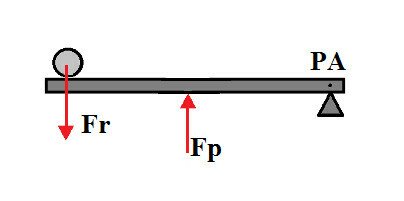"If you give me a lever and a foothold, I will displace the world." This was the phrase used by Archimedes to describe the function of a lever. It consists of a simple machine, is used to facilitate the execution of a job and has the ability to multiply the force applied to it. Its main functions are: lifting heavy objects, cutting, moving etc.
The lever consists of three elements:
PA – Support point: the point around which the lever can rotate;
FR – Resistant force: Weight of the object to be moved;
FP – Powerful force: Exercised with the aim of moving the object.
Levers can be classified into three types:
Interfixed lever: When the support point is located between the force application points and the object to be moved, as shown in the following figure. Examples of this type of lever are: pliers, scissors and seesaw.

The lever's fulcrum is between mighty strength and resistant strength
Inter-resistant lever: Resistant force is between fulcrum and mighty force. Examples of this type of lever are: the nutcracker, bottle openers and the wheelbarrow. Note the illustration:

Resistant strength is between fulcrum and mighty strength
Interpotent lever: In this type of lever, the powerful force is between the fulcrum and the resisting force. Examples of this type of lever are: tweezers and nail clippers. Look at the illustration:

Powerful strength is between fulcrum and resisting strength
By Mariane Mendes
Graduated in Physics
